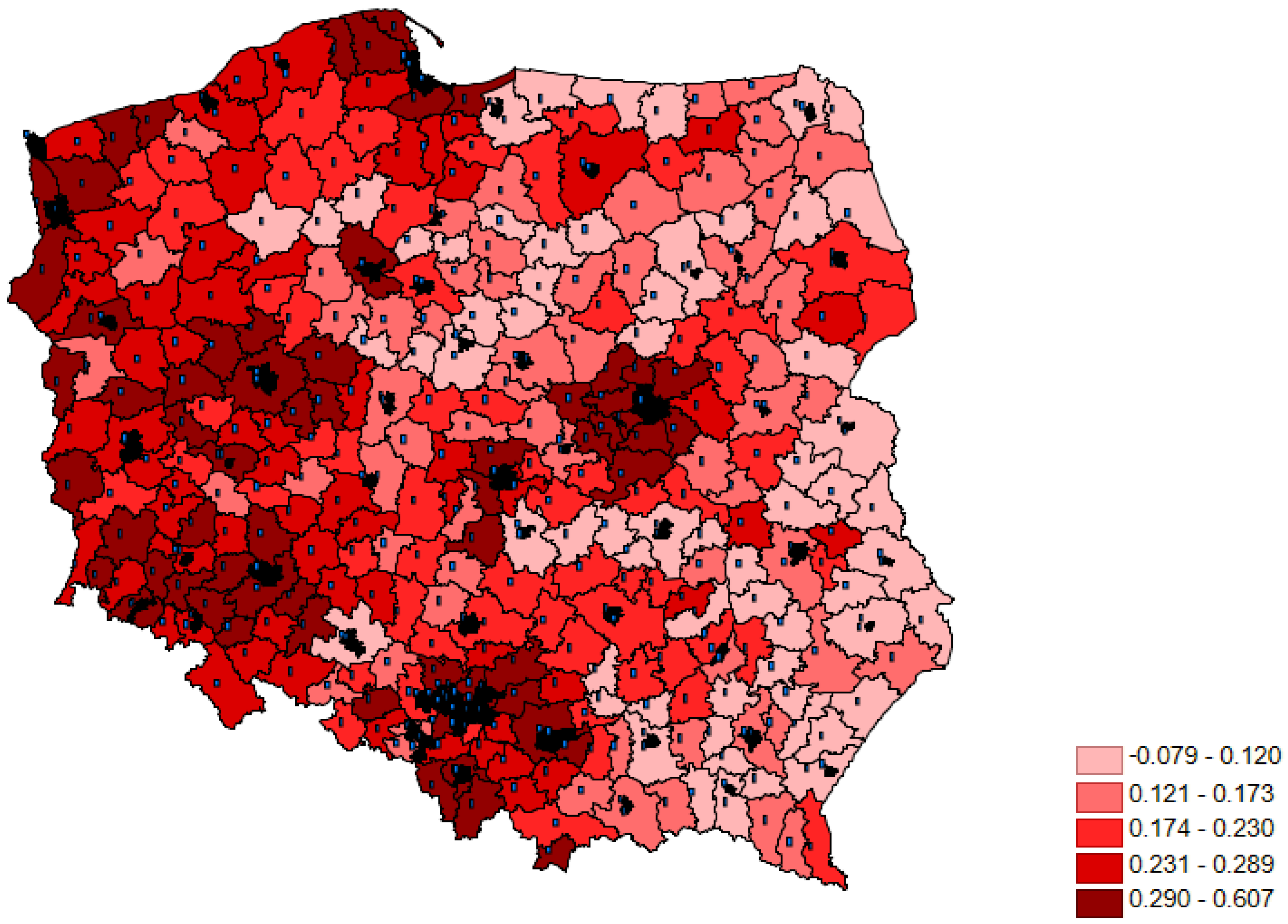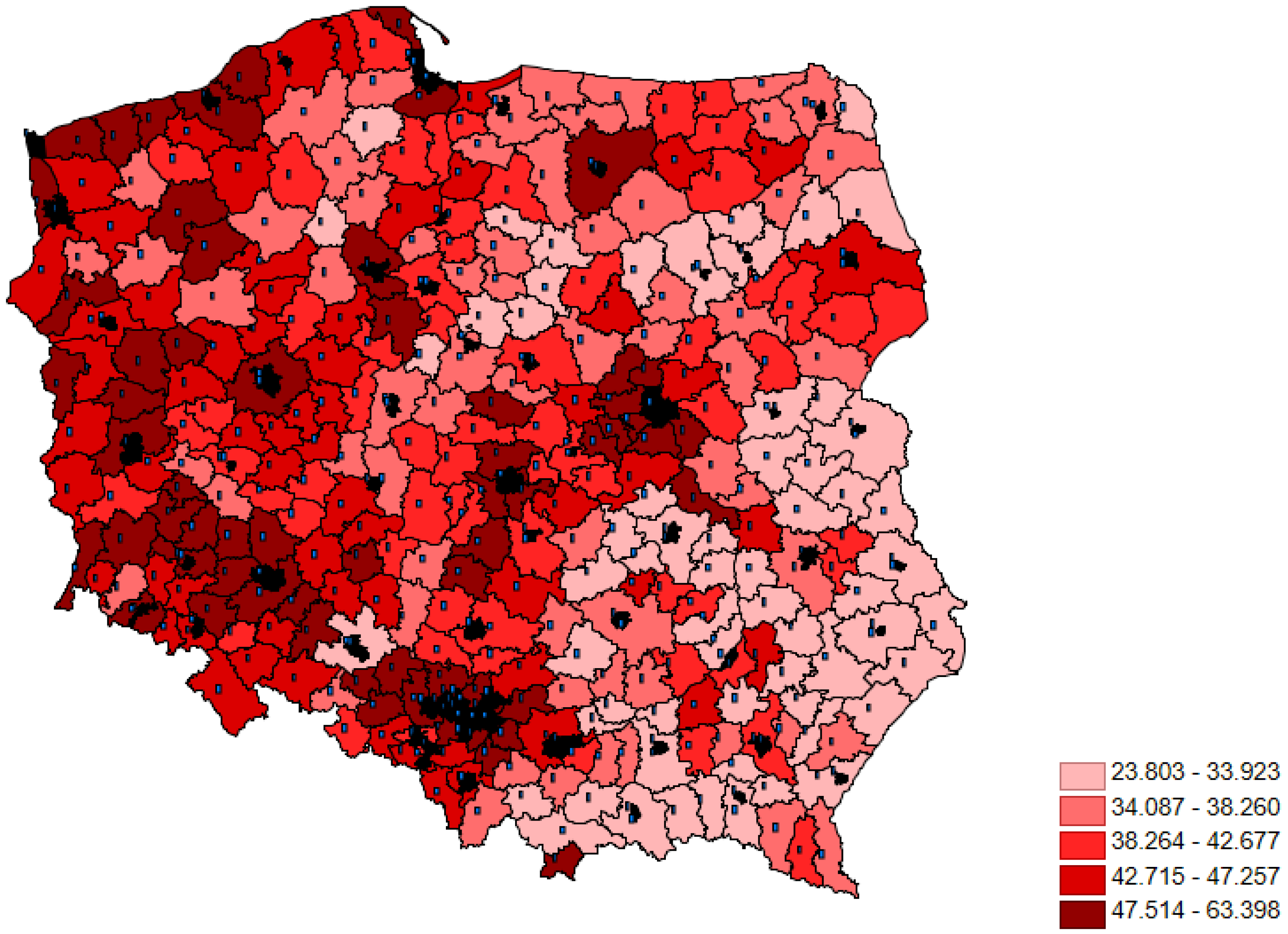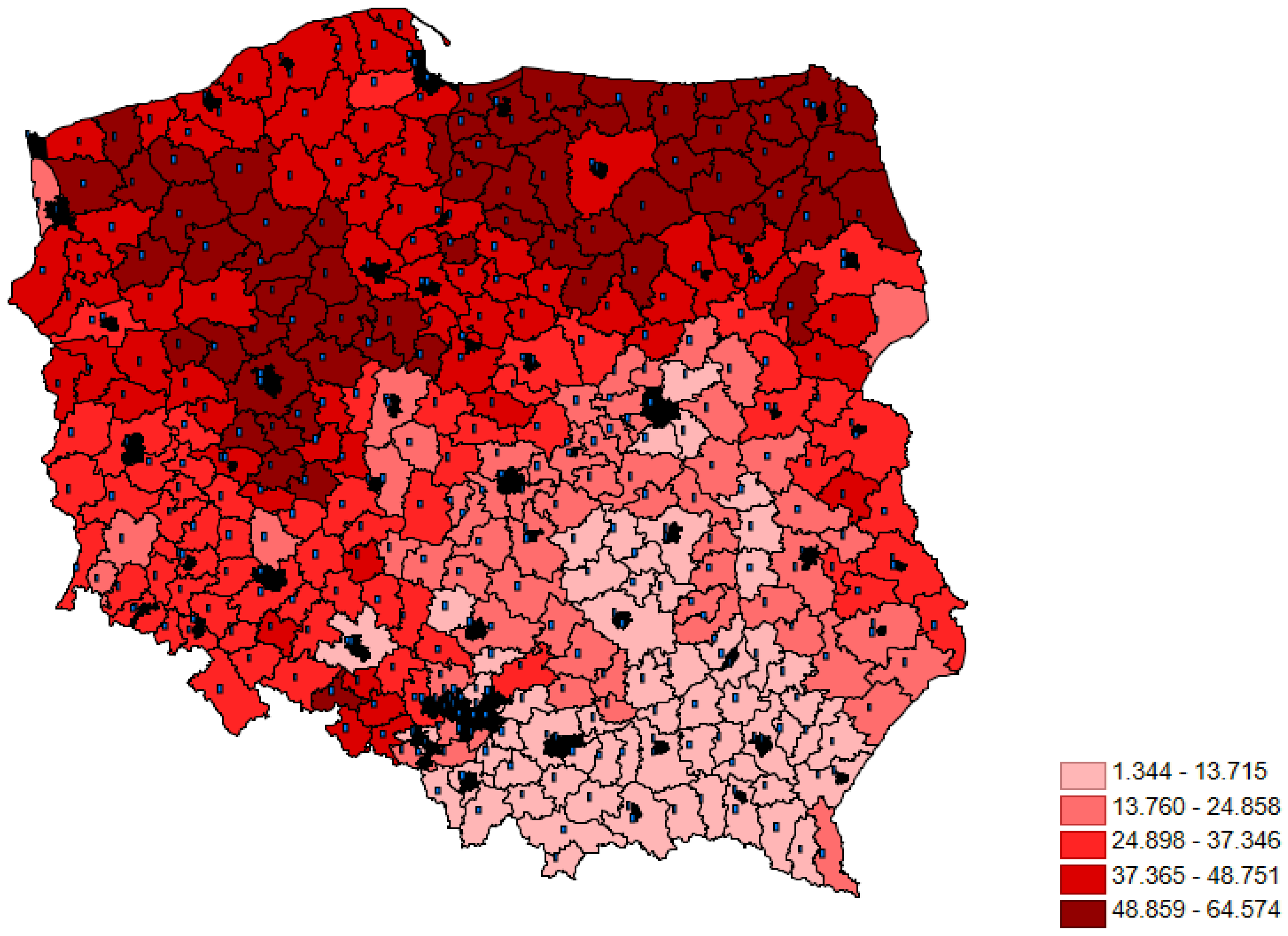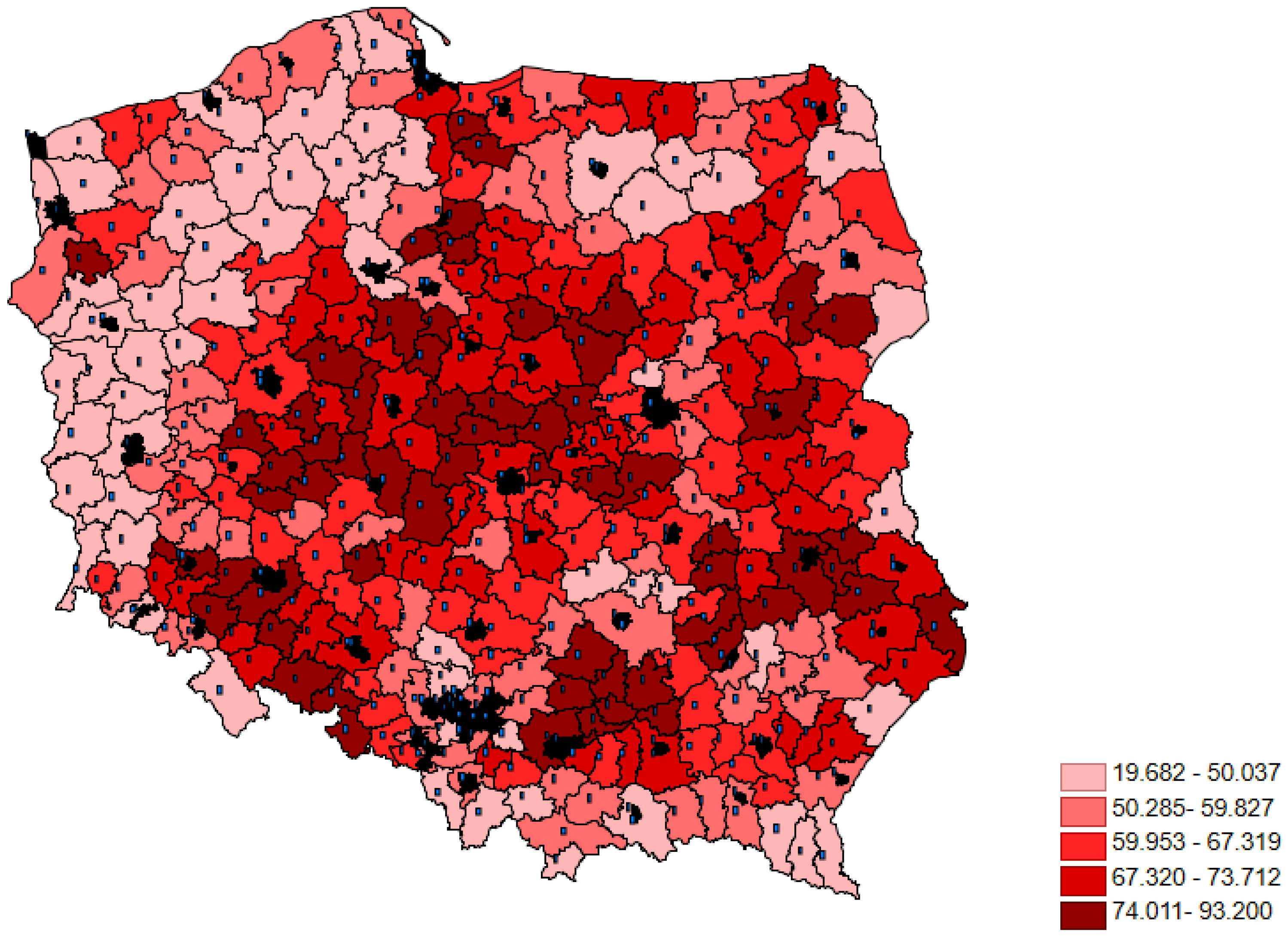Use of Union Funds in Developing Agricultural Entrepreneurship between 2014 and 2020 in Poland
Abstract
:1. Introduction
2. Materials and Methods
- The number of farms larger than 1 ha, grouped by size (as of 2020, Agricultural Census);
- The area used by farms larger than 1 ha, grouped by size and expressed in hectares (as of the 2020 Agricultural Census);
- The total area of the district in hectares (as of 2014);
- The area of agricultural land in the district, in hectares (as of 2014);
- The total budgetary income of communes, in PLN (as of 2021);
- The own budgetary income of communes, in PLN (as of 2021);
- The average gross monthly wage, in PLN (as of 2021);
- The number of registered employees remaining out of work for longer than 1 year (as of 2022);
- The number of economic operators per 1000 working-age population (as of 2023).
- Economy, a synthetic characteristic;
- The share of own incomes in total incomes at the commune level;
- The share of agricultural land in the area of the commune;
- The percentage of farms larger than 10 ha;
- The share of agricultural land held by farms larger than 10 ha.
- Selecting the simple characteristics for the phenomena considered;
- Normalizing the values of simple characteristics;
- Determining the values of synthetic characteristics;
- Determining Hellwig’s synthetic development metric.
- The availability of statistical data at the district level;
- A high relevance;
- A low correlation with other characteristics of the same phenomenon.
3. Results and Discussion
- Business start-up aid for young farmers (bonuses for young farmers);
- Business start-up aid for non-agricultural activities in rural areas (bonuses for the setting up of a non-agricultural activity);
- Business start-up aid for the development of small farms (restructuring of small farms;
- Enterprise development: development of agricultural services;
- Payments for farmers eligible for support under the system for small farms (Payments for farmers handing over small farms).
- The purchase or upgrade of buildings;
- The purchase, including installation, of new machinery and equipment, including computer hardware and software.
4. Conclusions
Author Contributions
Funding
Institutional Review Board Statement
Data Availability Statement
Conflicts of Interest
Abbreviations
References
- Tabares, A.; Londoño-Pineda, A.; Cano, J.A.; Gómez-Montoya, R. Rural Entrepreneurship: An Analysis of Current and Emerging Issues from the Sustainable Livelihood Framework. Economies 2022, 10, 142. [Google Scholar] [CrossRef]
- Akinbami, C.A.O.; Olawoye, J.E.; Adesina, F.A.; Nelson, V. Exploring potential climate-related entrepreneurship opportunities and challenges for rural Nigerian women. J. Glob. Entrep. Res. 2019, 9, 19. [Google Scholar] [CrossRef]
- Cano, J.A.; Londoño-Pineda, A. Scientific Literature Analysis on Sustainability with the Implication of Open Innovation. J. Open Innov. Technol. Mark. Complex. 2020, 6, 162. [Google Scholar] [CrossRef]
- Díaz, D.G.; Migdalia, D.C.; Enrique, D.C. Effect of rural entrepreneurship and innovation adoption in the reduction of inequalities. J. Sci. Res. 2019, 4, 268–290. [Google Scholar]
- Cederholm Björklund, J. Value Creation for Sustainable Rural Development Perspectives of Entrepreneurship in Agriculture; Halmstad University: Halmstad, Sweden, 2020. [Google Scholar]
- Barber, D., III; Harris, M.L.; Jones, J. An Overview of Rural Entrepreneurship and Future Directions. J. Small Bus. Strategy 2021, 31, 1–4. [Google Scholar] [CrossRef]
- Krzyżanowska, K.; Sikorska-Wolak, I. A theoretical and practical approach to entrepreneurship. In Rural Enterprise: Current Condition and Development Outlooks; Krzyżanowska, K., Ed.; Publishing House of the Warsaw University of Life Sciences: Warsaw, Poland, 2010; pp. 39–41. [Google Scholar]
- Stanny, M. Continuity and change: A century of rural development in Poland in a multidimensional scientific dialog. Rural. Areas Agric. 2019, 4, 7–24. [Google Scholar]
- Wojcieszak, M. Support instruments for rural entrepreneurship under the 2014–2020 RDP. In Rural Entrepreneurship: Concepts, Implementations, Axes of Development; Kosmaczewska, J., Barczak, M., Nowicki, R., Eds.; University Publishing House of the University of Economics: Bydgoszcz, Poland, 2016. [Google Scholar]
- Czyżewski, B.; Matuszczak, A.; Czyżewski, A.; Brelik, A. Public goods in rural areas as endogenous drivers of income: Developing a framework for country landscape valuation. Land Use Policy 2020, 107, 104646. [Google Scholar] [CrossRef]
- Kumari, G.; Ebikinei, S.E. Social Entrepreneurship Among Artisans. In Artisan and Handicraft Entrepreneurs; Springer: Berlin/Heidelberg, Germany, 2022; pp. 161–182. [Google Scholar]
- Robert, F.C.; Frey, L.M.; Sisodia, G.S. Village development framework through self-help-group entrepreneurship, microcredit, and anchor customers in solar microgrids for cooperative sustainable rural societies. J. Rural Stud. 2021, 88, 432–440. [Google Scholar] [CrossRef]
- Wojcieszak-Zbierska, M.; Zawadka, J. Female entrepreneurial activities in rural areas: A case study of the Farmers’ Wives’ Association in the Gniezno district. Tour. Reg. Dev. 2019, 11, 127–138. [Google Scholar]
- Durand, G.; van Huylenbroeck, G. Multifunctionality and rural development: A general framework. In Multifunctional Agriculture: A New Paradigm for European Agriculture and Rural Development; van Huylenbroeck, G., Durand, G., Eds.; Ashgate: Aldershot, UK, 2003. [Google Scholar]
- Wilkin, J. Multipurpose Agriculture: A New Approach to the Role of Agriculture in the Economy and Society; Multi-Functionality of Agriculture. Research Trends, Methodological Foundations and Practical Implications; Wilkin, J., Ed.; Institute of Rural and Agricultural Development of the Polish Academy of Sciences: Warsaw, Poland, 2003. [Google Scholar]
- Doitchinova, J. Multifunctional agriculture as opportunity for rural development. Trakia J. Sci. 2005, 3, 41–43. [Google Scholar]
- Bogusz, M.; Wojcieszak-Zbierska, M. Multipurpose rural development in selected European Union countries (examples of implemented projects). Ann. Pol. Assoc. Agric. Agribus. Econ. 2020, 22, 42–52. [Google Scholar] [CrossRef]
- Wojtyra, B. Poziom wielofunkcyjnego rozwoju obszarów wiejskich województwa wielkopolskiego. Rozw. Reg. I Polityka Reg. 2017, 40, 149–161. [Google Scholar]
- Long, H.; Li, M.; Zhang, Y.; Qu, L. Multifunctional rural development in China: Pattern, process and mechanism. Habitat Int. Vol. 2022, 121, 102530. [Google Scholar] [CrossRef]
- Stanny, M.; Rosner, A.; Komorowski, Ł. Monitoring of rural development. Stage III. In Socioeconomic Structures, Their Spatial Differentiation and Dynamics; IRWiR PAN: Warsaw, Poland, 2018. [Google Scholar]
- Torre, A.; Wallet, F.; Huang, J. A collaborative and multidisciplinary approach to knowledge-based rural development: 25 years of the PSDR program in France. J. Rural Stud. 2023, 97, 428–437. [Google Scholar] [CrossRef]
- 2014–2020 Rural Development Program; Ministry of Agriculture and Rural Development: Warsaw, Poland. 2014. Available online: https://www.gov.pl/web/rolnictwo/-program-rozwoju-obszarow-wiejskich-2014-2020-prow-2014-2020 (accessed on 7 November 2023).
- Dixit, K.; Debashish, S. Start-up Village Entrepreneurship Programme: From Local to Vocal. Contemp. Voice Dalit 2022, 10, 1–14. [Google Scholar] [CrossRef]
- Adamowicz, MConditions for multipurpose agricultural development and changes to today’s agricultural policy. Issues Agric. Econ. 2005, 1, 17–32.
- Kulawiak, A.; Suliborski, A.; Rachwał, T. Research on Rural Entrepreneurship in Terms of the Literature: Definition Problems and Selected Research Issues. Quaest. Geogr. 2022, 41, 7–19. [Google Scholar] [CrossRef]
- Sikorska-Wolak, I. The multifaceted nature of entrepreneurship and how it is viewed by the rural population. In Consultancy Services in a Business Activity; Krzyżanowska, K., Ed.; Publishing House of the Warsaw University of Life Sciences: Warsaw, Poland, 2008. [Google Scholar]
- Sadowski, A.; Wojcieszak-Zbierska, M.; Beba, P. Territorial differences in agricultural investments co-financed by the European Union in Poland. Land Use Policy 2020, 100, 1–13. [Google Scholar] [CrossRef]
- Halamska, M. Rural Poland in the Early 2000s: Economic and Social Considerations; Scholar Publishing House: Warsaw, Poland, 2013. [Google Scholar]
- Leszczyńska, C. Rural areas after the end of landlordism. In Continuity and Changes. A Centenary of Rural Development in Poland; Halamska, M., Stanny, M., Wilkin, J., Eds.; Institute of Rural and Agriculture Development of the Polish Academy of Sciences, Scholar Spółka z o.o. Scientific Publishing House: Warsaw, Poland, 2019; Volume 1–2. [Google Scholar]
- EU: Research for AGRI Committee—The Role of the EU’s Common Agricultural Policy in Creating Rural Jobs 2016. Available online: https://www.europarl.europa.eu/RegData/etudes/STUD/2016/573418/IPOL_STU(2016)573418_EN.pdf (accessed on 1 November 2013).
- Brelik, A. Economic Activity of Farms Against Farms Countries of the European Union. Sci. J. Wars. Univ. Life Sci.—SGGW. Probl. World Agric. 2016, 16, 86–91. [Google Scholar] [CrossRef]
- Li, C.; Sha, Z.; Sun, X.; Jiao, Y. The Effectiveness Assessment of Agricultural Subsidy Policies on Food Security: Evidence from China’s Poverty-Stricken Villages. Int. J. Environ. Res. Public Health 2022, 19, 13797. [Google Scholar] [CrossRef]
- Central Statistical Office, Local Data Bank. Available online: https://bdl.stat.gov.pl/bdl/start (accessed on 1 August 2023).
- Łuczak, A.; Kozera, A.; Bacci, S. The application of taxonomic methods and ordered logit model in the assessment of financial self-sufficiency of local administrative units. In Proceedings of the 2018 International Conference “Economic Science for Rural Development”, Jelgava, Latvia, 9–11 May 2018; pp. 212–220. [Google Scholar]
- Wołoszyn, A.; Stanisławska, J.; Wołoszyn, R.; Kozera, A.; Rosa, A. Multidimensional Assessment of Polish Farm Household Financial Security by TOPSIS and Generalised Distance Measure. Eur. Res. Stud. J. 2021, 24, 534–553. [Google Scholar] [CrossRef] [PubMed]
- Wojcieszak, M. Conditions for, and Economic Effects of, the Development of Nature Tourism in Metropolitan Areas; Publishing House of the Poznań University of Life Sciences: Poznań, Poland, 2017. [Google Scholar]
- Dyr, T.; Ziółkowska, K. Economic infrastructure as factor of the region’s competitiveness. Cent. Eur. Rev. Econ. Financ. 2014, 6, 534–553. [Google Scholar]
- Roszkowska, E.; Filipowicz-Chomko, M. Measuring Sustainable Development Using an Extended Hellwig Method: A Case Study of Education. Soc. Indic. Res. 2021, 153, 299–322. [Google Scholar] [CrossRef]
- Reiff, M.; Surmanová, K.; Balcerzak, A.P.; Pietrzak, M.B. Multiple Criteria Analysis of European Union Agriculture. J. Int. Stud. 2016, 9, 62–74. [Google Scholar] [CrossRef]
- Krajewska-Szkudlarek, J.; Łyczko, W. Assessment of Hellwig Method for Predictors’ Selection in Groundwater Level Time Series Forecasting. Water 2021, 13, 778. [Google Scholar] [CrossRef]
- Wysocki, F.; Lira, J. Descriptive Statistics; Publishing House of the August Cieszkowski Agricultural University: Poznań, Poland, 2005. [Google Scholar]
- Czyżewska, M.; Pach, J.; Sala, K. Social Economy and Entrepreneurship. In Innovations vs. the Environment; CeDeWu Publishing House: Warsaw, Poland, 2020. [Google Scholar]
- Marciniak, M. Entrepreneurship Development as an Opportunity for Polish Rural Areas; Civic Institute: Warsaw, Poland, 2011. [Google Scholar]
- Poczta, W. Changes in Polish agriculture during the economic transformation and Poland’s accession to the EU. Agric. Rural Areas 2020, 2, 57–77. [Google Scholar]
- Lang, R.; Matthias, F. Rural social entrepreneurship: The role of social capital within and across institutional levels. J. Rural Stud. 2019, 70, 155–168. [Google Scholar] [CrossRef]
- Halamska, M.; Stanny, M. Temporal and spatial diversification of rural social structure: The case of Poland. Sociol. Rural 2021, 61, 578–601. [Google Scholar] [CrossRef]
- Kłodziński, M. Socioeconomic Empowerment of Rural Communes and Small Cities; Institute of Rural and Agriculture Development of the Polish Academy of Sciences: Warsaw, Poland, 2006. [Google Scholar]
- Woś, A. Encyclopedia of Agribusiness; Fundacja Innowacja, School of Social and Economic Studies: Warsaw, Poland, 1998. [Google Scholar]
- Sieczko, L.; Parzonko, A.J.; Sieczko, A. Trust in collective entrepreneurship in the context of the development of rural areas in Poland. Agriculture 2021, 11, 1151. [Google Scholar] [CrossRef]
- Siemiński, P.; Hadyński, J.; Poczta, W. Differences in human capital resources across rural and urban areas in Poland. Ann. PAAAE 2020, 22, 300–311. [Google Scholar] [CrossRef]
- Pawlik, A.; Dziekański, P. Entrepreneurship as the basis for the development of rural communes in Eastern Poland. Balt. J. Econ. Stud. 2021, 7, 1–11. [Google Scholar] [CrossRef]
- Milán-García, J.; Uribe-Toril, J.; Ruiz-Real, J.L.; de Pablo Valenciano, J. Sustainable Local Development: An Overview of the State of Knowledge. Resources 2019, 8, 31. [Google Scholar] [CrossRef]
- Tabares, A. International entrepreneurship under an institutional regulative dimension: A cross-national study. Espacios 2017, 38, 2. [Google Scholar]
- Stańko, A. Entrepreneurship as a driver of rural development. Food Econ. Organ. 2009, 79, 99–109. [Google Scholar]
- Wilkin, J. Foundation of the Strategy for Integrated Agricultural and Rural Development in Poland; Publishing House of the University of Warsaw, Faculty of Economic Sciences: Warsaw, Poland, 2003. [Google Scholar]
- Li, Y.; Hans, W.; Liu, Y. Why some rural areas decline while some others not: An overview of rural evolution in the world. J. Rural Stud. 2019, 68, 135–143. [Google Scholar] [CrossRef]
- 2022 Report by the Polish Agency for Enterprise Development. In Report on the Condition of the SME Sector in Poland in 2022; Polish Agency for Enterprise Development: Warsaw, Poland, 2022.
- Idziak, W.; Idziak, P.; Kamiński, R. Support for Rural Tourism and Agritourism Development under the 2014–2020 Rural Development Program and under National and Regional Operational Programs for the Ministry of Agriculture and Rural Development: An Expert Assessment; Warsaw, Poland. 2015. Available online: https://www.gov.pl/web/rolnictwo/wsparcie-dla-rozwoju-turystyki-wiejskiej-i-agroturystyki-w-ramach-programu-rozwoju-obszarow-wiejskich-na-lata-2014-2020-oraz-z-krajowych-i-regionalnych-programow-operacyjnych (accessed on 11 November 2023).
- Parzonko, A. Development of collective rural entrepreneurship; psychological and economical aspects of the functioning of agricultural producer groups. In Rural Enterprise: Current Condition and Development Outlooks; Krzyżanowska, K., Ed.; Publishing House of the Warsaw University of Life Sciences: Warsaw, Poland, 2010. [Google Scholar]
- Pato, L.; Teixeira, A.A. Rural entrepreneurship: The tale of a rare event. J. Place Manag. Dev. 2018, 11, 46–59. [Google Scholar] [CrossRef]
- Pato, M.L.; Teixeira, A.A. Twenty Years of Rural Entrepreneurship: A Bibliometric Survey. Sociol. Rural 2016, 56, 3–28. [Google Scholar] [CrossRef]
- Regulation (EU) No. 1305/2013 of the European Parliament and of the Council of 17 December 2013 on Support for Rural Development by the European Agricultural Fund for Rural Development (EAFRD) and Repealing Council Regulation (EC) No. 1698/2005 (Official Journal of the European Union L 347 of 20 December 2013, p. 487). Available online: https://eur-lex.europa.eu/LexUriServ/LexUriServ.do?uri=OJ:L:2013:347:0487:0548:EN:PDF (accessed on 11 November 2023).
- 2023–2027 Strategic Plan for the Common Agricultural Policy; Ministry of Agriculture and Rural Development: Warsaw, Poland. 2022. Available online: https://www.gov.pl/web/rolnictwo/programowanie-ps-wpr (accessed on 11 November 2023).
- Kiryluk-Dryjska, E. Using linear optimization in allocating financial resources to selected measures under the 2014–2020 RDP. J. Agribus. Rural. Dev. 2014, 3, 61–73. [Google Scholar]
- Sadowski, A. Reasons behind geographical differences in the absorption of selected forms of support under the 2007–2013 Rural Development Program. Agric. Consult. Issues 2020, 1, 30–47. [Google Scholar]
- Beba, P. Optimization Models for Regional Allocation of Structural Funds of the Common Agricultural Policy in Poland; Publishing House of the Poznań University of Life Sciences: Poznań, Poland, 2017. [Google Scholar]
- Agency for Restructuring and Modernization of Agriculture. Available online: www.arimr.gov.pl (accessed on 1 October 2023).
- Czarnecki, A. National urbanization and its stages. In Continuity and Changes. A Centenary of Rural Development in Poland; Halamska, M., Stanny, M., Wilkin, J., Eds.; Institute of Rural and Agriculture Development of the Polish Academy of Sciences, Scholar Spółka z o.o. Scientific Publishing House: Warsaw, Poland, 2019; Volume 1–2. [Google Scholar]
- Jezierski, A.; Leszczyńska, C. Economic History of Poland; Key Tex: Warsaw, Poland, 2010. [Google Scholar]
- Sadowski, A.; Wojcieszak, M.M. Geographic differentiation of agritourism activities in Poland vs. cultural and natural attractiveness of destinations at district level. PLoS ONE 2019, 14, e0222576. [Google Scholar] [CrossRef]
- Murawska, A. Factors differentiating the level of unemployment in rural households in Poland. Assoc. Agric. Agribus. Econ. 2015, 283, 283–289. [Google Scholar]






| Simple Characteristic | Type (Effect) of Characteristics | Data Source |
|---|---|---|
| Gross average monthly wage (PLN/month per capita) | stimulating | https://bdl.stat.gov.pl/BDL/start (accesed on 1 August2023) |
| Share of registered employees remaining out of work for longer than 1 year in the working-age population (%) | inhibiting | https://bdl.stat.gov.pl/BDL/start (accesed on 1 August 2023) |
| Economic operators per 1000 working-age population | stimulating | https://bdl.stat.gov.pl/BDL/start (accesed on 1 August 2023) |
| Variable | “Economy”, a Synthetic Characteristic | Share of Own Incomes in Total Incomes at Commune Level | Share of Agricultural Land in the Area of the Commune | Percentage of Farms Larger than 10 ha | Share of Agricultural Land Held by Farms Larger than 10 ha |
|---|---|---|---|---|---|
| Payments under the sub-measure “Bonuses for the setting up of a non-agricultural activity” (PLN per hectare of agricultural land) | −0.17 | −0.38 | 0.09 | −0.52 | −0.63 |
Disclaimer/Publisher’s Note: The statements, opinions and data contained in all publications are solely those of the individual author(s) and contributor(s) and not of MDPI and/or the editor(s). MDPI and/or the editor(s) disclaim responsibility for any injury to people or property resulting from any ideas, methods, instructions or products referred to in the content. |
© 2023 by the authors. Licensee MDPI, Basel, Switzerland. This article is an open access article distributed under the terms and conditions of the Creative Commons Attribution (CC BY) license (https://creativecommons.org/licenses/by/4.0/).
Share and Cite
Wojcieszak-Zbierska, M.M.; Sadowski, A. Use of Union Funds in Developing Agricultural Entrepreneurship between 2014 and 2020 in Poland. Agriculture 2024, 14, 83. https://doi.org/10.3390/agriculture14010083
Wojcieszak-Zbierska MM, Sadowski A. Use of Union Funds in Developing Agricultural Entrepreneurship between 2014 and 2020 in Poland. Agriculture. 2024; 14(1):83. https://doi.org/10.3390/agriculture14010083
Chicago/Turabian StyleWojcieszak-Zbierska, Monika Małgorzata, and Arkadiusz Sadowski. 2024. "Use of Union Funds in Developing Agricultural Entrepreneurship between 2014 and 2020 in Poland" Agriculture 14, no. 1: 83. https://doi.org/10.3390/agriculture14010083
APA StyleWojcieszak-Zbierska, M. M., & Sadowski, A. (2024). Use of Union Funds in Developing Agricultural Entrepreneurship between 2014 and 2020 in Poland. Agriculture, 14(1), 83. https://doi.org/10.3390/agriculture14010083






